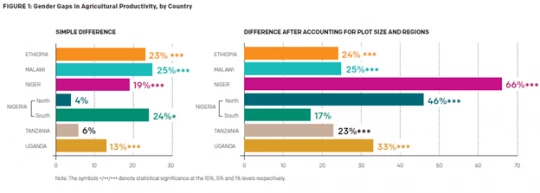With the Comprehensive Africa Agriculture Development Program (CAADP) Partnership Platform meeting underway this week in Durban, policymakers are seeking ways to boost agricultural productivity and promote inclusive growth in Africa. Investing in Africa’s female farmers offers one promising path forward.
Women contribute close to half of Africa’s crop labor yet a host of factors constrain their contribution to Africa’s overall productivity. Policymakers need better evidence before they can chart a course of action. Where should they focus their resources? Which factors need tackling first? And what, if any, sound evidence is available on investments that can yield deep impacts?
A new evidence-based policy report from the World Bank’s Gender Innovation Lab and The ONE Campaign, “Leveling the Field: Improving Opportunities for Women Farmers in Africa,” breaks new ground by comprehensively documenting the gender gap and prioritizing areas for action to help policymakers – and their citizens – harvest the gains from equality.
Previous attempts to document and analyze the gender gap in farm productivity were stymied both by the limited availability of evidence, scattered across small study areas, and the ways in which the data were collected, limiting what researchers could say about gender differences within farming households. The new World Bank-ONE report benefits from better data and new approaches to analyzing gender gaps, allowing us to offer the most complete picture to date of the sector’s costly inequalities.
The new report draws on a treasure trove of new data to document the magnitude of gender gaps across Africa. The World Bank’s Living Standards Measurement Study - Integrated Surveys on Agriculture (LSMS-ISA) datasets provide detailed, harmonized, nationally-representative agricultural plot data from six countries (Ethiopia, Malawi, Niger, Nigeria, Tanzania, and Uganda) that comprise more than 40% of Africa’s population. Based on simple comparisons of averages from these six countries, women produce up to a quarter less than men (see Figure 1). Yet after accounting for regional differences and the fact that women tend to farm smaller plots than men, one arrives at a much starker conclusion: significant gender gaps range from 23% in Tanzania to a strikingly large 66% in Niger.
Source: Leveling the Field: Improving Opportunities for Women Farmers in Africa (World Bank/ONE)
But what are the biggest factors behind these gaps? The report employs a well-tested approach from labor economics, known as Oaxaca decomposition, in a novel way to isolate the relative importance of each factor (land, labor, credit, etc.) for the gender gap. This approach is particularly useful for policy since it helps us zero in on the priority areas for action.
A number of groundbreaking conclusions emerge from this analysis. First, whereas previous studies on the gender gap have focused on differences in access to resources, the new World Bank-ONE report shows that the costly gender productivity gap is about more than just access. Indeed, gender differences in returns to the same amount of a factor explain much of the gap. For example, in Ethiopia, differences in returns explain more than half (57%) of the gender gap in agricultural productivity. Although men and women use similar quantities of inorganic fertilizer on their plots (equality of access), men receive higher yields from the use of fertilizer than women (inequality of returns). Such a finding can have a profound impact on the design of policy, as the root of the problem may be gender differences in the quality of the fertilizer used or when or how the fertilizer is applied.
Second, we now have a much more thorough and systematic assessment of what is driving Africa’s gender gap. While each country’s gender gap is unique, it is clear from the new report that some key factors – labor, fertilizer, and land – cut across all contexts. Indeed, labor, particularly gender differences in the quantity and efficiency of male farm labor, emerges from the report as the chief barrier to bridging Africa’s productivity divide. This finding underscores the need for concerted policy action and knowledge generation to identify ways to help women farmers overcome this labor obstacle.
So what specific steps should policymakers and development partners take? The report closes with a ten-point policy action plan, grounded in available evidence from rigorous impact evaluations and other empirical research. Interested in reading those findings? Have a look yourself.



Join the Conversation